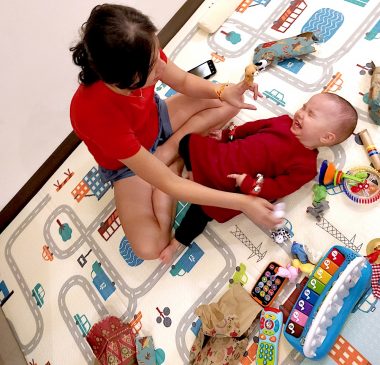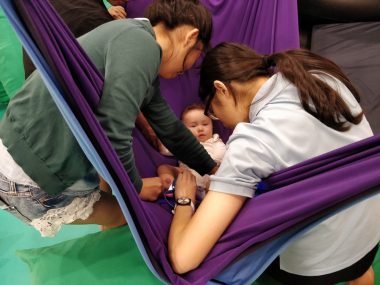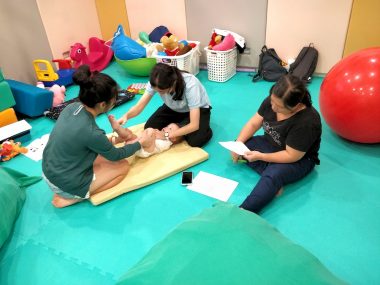Sensing How Our Children With AADC Deficiency Perceive the World

Imagine that arms reach into your warm and dark shelter of solitude and thrust you into blinding lights and chaos. Cool air surrounds you and tickles your skin. As your eyes try to adjust, strange music combined with screaming disorients you further. Fear grips you when strange foreign objects are suddenly thrust in front of your face and into your hands.
Sounds dreadful, right? That is what my daughter, Rylae-Ann, may experience when we take her out for traditional family activities. From a parent’s perspective, it seems like a terrific bonding experience. However, it’s anything but terrific for my daughter.
Sensory processing issues
Aromatic l-amino acid decarboxylase (AADC) deficiency is an inherited genetic disorder that disrupts communication in the brain, resulting in the improper production of dopamine and serotonin. These two vital chemicals are involved in a wide range of bodily processes, including mood regulation, sleep, and other functions that contribute to overall well-being.
The neurotransmitter deficiency can lead to heightened anxiety and depression. In these states, children are unable to properly play or learn. In pedagogy, we associate this inhibition with Maslow’s hierarchy of needs, which states that motivation is connected to psychological and self-fulfillment needs and dictates an individual’s behavior. If you don’t address the fundamental psychological, safety, and affection needs, you will be incapable of achieving a conducive state for learning.
So the question is, if our children have heightened anxiety and become easily scared of the slightest change in their senses or environment, how can we achieve learning?
The answer, I believe, is sensory integration.

Rylae-Ann did not like toys, so through sensory integration activities, we helped her to feel less anxious. (Photo by Richard E. Poulin III)
Sensory integration
The concept of sensory integration was developed by occupational therapist Anna Jean Ayres, who noticed how sensory and movement planning issues interfered with occupational therapy and learning objectives. Since then, further studies about neuropsychology, neurology, physiology, child development, and psychology have significantly contributed to the formation of these sensory integration and treatment strategies.
When discussing the sense of feeling, it’s essential to note that the experience encompasses more than just touch. It also involves kinesiology, proprioception, vision, hearing, and gravity. The brain is typically very efficient at managing, organizing, and interpreting all these senses, but this is not the case for children with a neurotransmitter disorder.
Sensory integration aims to provide strategies for a patient’s mind to cope with the significant influx of stimuli. This leads to progress in learning and other paramedical therapies. Through activities and games, children are gradually exposed to sensations in a controlled and safe manner.
Before gene therapy, we took our daughter to a sensory integration center in Taiwan. It was beneficial, but we couldn’t commit as we were living in Singapore at the time. We never revisited sensory integration, but after gene therapy, we noticed that many of the challenges Rylae-Ann has now are related to the sensory processing issues she had back then. Early intervention with sensory integration would have led to more progress as it directly affects a child’s movement and planning abilities.

Through a combination of sensory integration methods, Rylae-Ann improved and was able to tolerate more stimuli. (Photo by Richard E. Poulin III)
Ignoring sensory integration
We’ve known that managing sensations has been an issue for Rylae-Ann since she was born. However, our naive solution at the time was to retreat into our home, make it cool and dark, and just soothe our daughter. This was an instinctive reaction, but we limited her progress.
When we first visited an indoor playground, I was anxious and anticipated an outburst. As soon as I yanked my daughter out of her cocoon of a stroller, she went into meltdown mode. My solution was to head home and not return. Instead, we should have been mindful of internal self-management and incorporated more sensory integration.
We are now revisiting sensory integration. Below is a brief overview of the methodologies we have tried and are currently trying again. You can discuss this with your therapist and begin working on sensory integration, a play-based therapy that includes equipment like swings, slides, weighted vests, play dough, and other enticing children’s toys.

A trained therapist teaches Rylae-Ann’s mom and nanny sensory integration activities and tips to apply at home. (Photo by Richard E. Poulin III)
Masgutova Tactile System Integration
Masgutova Tactile System Integration combines neurosensory exercises and reflex integration to improve all kinds of movement. This was especially useful before gene therapy since the only movements we saw resulted from reflex integration. It also promotes sensory modulation, emotional resilience, and sensory-motor rehabilitation.
Quantum Reflex Integration
Quantum Reflex Integration combines sound and light stimuli to also promote reflex integration. It aims to help children learn to overcome cognitive, behavioral, and emotional problems and improve motor development.
Qigong Sensory Treatment
Qigong Sensory Treatment is based on traditional Chinese medicine and the concept of “qi,” an energy force that permeates all life. It is categorized as preventive medicine and applied to autism and sensory modulation difficulties. It incorporates a tactile “energy massage.” In addition to improving response to touching, it can also improve sleep. We combined this with strategies we learned from baby massage classes and performed it every night before bed.
Start early and be consistent
We did not start early or follow through with treatment, and now we have to reconsider this therapy. Being consistent would have helped our daughter develop a state of mind that would’ve allowed her to be more successful in various environments and activities, due to improved physical, speech, eating, and occupational abilities. Talk with your therapist or visit a clinic near you. Remember to take home strategies to maximize the benefits of sensory integration therapy.
Note: AADC News is strictly a news and information website about the disease. It does not provide medical advice, diagnosis, or treatment. This content is not intended to be a substitute for professional medical advice, diagnosis, or treatment. Always seek the advice of your physician or other qualified health provider with any questions you may have regarding a medical condition. Never disregard professional medical advice or delay in seeking it because of something you have read on this website. The opinions expressed in this column are not those of AADC News or its parent company, Bionews, and are intended to spark discussion about issues pertaining to aromatic l-amino acid decarboxylase deficiency.








Leave a comment
Fill in the required fields to post. Your email address will not be published.